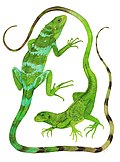| Andros Island iguana | |
|---|---|
|
Scientific classification
| |
| Domain: | Eukaryota |
| Kingdom: | Animalia |
| Phylum: | Chordata |
| Class: | Reptilia |
| Order: | Squamata |
| Suborder: | Iguania |
| Family: | Iguanidae |
| Genus: | Cyclura |
| Species: | |
| Subspecies: | C. c. cychlura
|
| Trinomial name | |
| Cyclura cychlura cychlura (
Cuvier, 1829)
| |
The Andros Island iguana or Andros iguana (Cyclura cychlura cychlura) is an endangered subspecies of Northern Bahamian rock iguana of the genus Cyclura that is found on Andros Island on the western edge of Grand Bahama. Its status is Endangered, with a wild population of 3,500 animals, and it can be found on the IUCN Red List. [1]
Taxonomy
The Andros Island iguana, Cyclura cychlura cychlura, is endemic to the island of Andros. [1] [2] It is one of three subspecies of the Northern Bahamian rock iguana; the other two subspecies being Allen's Cay iguana (Cyclura cychlura inornata) and the Exuma Island iguana ( Cyclura cychlura figginsi). [1] [2]
Anatomy and morphology
The Andros Island iguana is one of the largest species of rock iguana which attains a total length of close to 1.5 m (4 ft 11 in). [1] [3] [4] Its coloration is dark-gray to black, with yellowish green or orange tinged scales on the legs, dorsal crest, and the head. When the animal matures, the yellow coloration changes to a bright reddish orange color in contrast to the animals darker striped body and black feet. [4]
This species, like other species of Cyclura, is sexually dimorphic; males are larger than females, and have more prominent dorsal crests as well as larger femoral pores on their thighs, which are used to release pheromones. [5] [6]
Ecology
Andros Island iguanas are host to a reptile tick, Amblyomma dissimile. [7]
Diet
Like all Cyclura species, the Andros Island iguana is primarily herbivorous, consuming leaves, flowers, and fruits from over 100 different plant species. This diet is very rarely supplemented with insect larvae, crabs, slugs, dead birds, rats, and fungi.
Reproduction
Mating occurs from early April to early May, with eggs deposited in nests excavated within termite mounds ( Nasutitermes rippertii). [8] This is the only species of iguana known to use termite mounds as a means of incubating its eggs. [3] Females are known to guard their nests until hatching occurs. [4]
The newly hatched iguanas disperse away from the nest site for the first two or three weeks. During the first week, the hatchlings are vulnerable to predation by snakes; less than one-third of hatchlings survive their first month. [9]
Conservation
Endangered Status
It is estimated that the current global population is less than 3,500 members and is declining. [4] The population has decreased by at least 50% over the last 60 years. [1] [3]
Causes of decline
Hunting is the main factor threatening imminent extinction for this iguana. [1] [3] [4] It is the only Caribbean species of iguana which is still regularly hunted for food for human consumption. [1] [3] [4] Feral pigs pose a threat to the iguanas, as they dig up eggs from iguana nests within termite mounds. [1] [3] [4] Feral and domestic dogs prey upon juvenile and adult iguanas as well. [1] [3] [4] Feral goats have also been known to compete with the iguanas for food. [1]
As with other rock iguanas, their habitat is in rapid decline due to development and logging. [1]
Recovery efforts
Like all Bahamian rock iguanas, this species is protected in the Bahamas under the Wild Animals Protection Act of 1968. [1] However, no areas have been specifically designated for the protection of iguanas on Andros and no specific conservation programs are in place. [1]
There are currently no captive breeding programs for this animal.
References
- ^ a b c d e f g h i j k l m Knapp, C.R.; Buckner, S.D. (2004). "Cyclura cychlura ssp. cychlura". IUCN Red List of Threatened Species. 2004: e.T6039A12349025. doi: 10.2305/IUCN.UK.2004.RLTS.T6039A12349025.en. Retrieved 12 November 2021.
- ^ a b Hollingsworth, Bradford D. (2004). "The Evolution of Iguanas: An Overview of Relationships and a Checklist of Species". Iguanas: Biology and Conservation. University of California Press: 36–37. ISBN 978-0-520-23854-1.
- ^ a b c d e f g "Andros Iguana". International Iguana Foundation - Andros Iguana. International Iguana Foundation. 2006-02-15. Archived from the original on 2007-08-07. Retrieved 8 September 2007.
- ^ a b c d e f g h Morgan, Curtis (2002-07-07). "In Bahamas Some Indulge Taste For Dwindling Iguana". Miami Herald. Archived from the original on 2008-06-19. Retrieved 2007-10-14.
- ^ De Vosjoli, Phillipe; David Blair (1992). The Green Iguana Manual. Escondido, California: Advanced Vivarium Systems. ISBN 1-882770-18-8.
- ^ Martins, Emilia P.; Lacy, Kathryn (2004). "Behavior and Ecology of Rock Iguanas,I: Evidence for an Appeasement Display". Iguanas: Biology and Conservation. University of California Press: 98–108. ISBN 978-0-520-23854-1.
- ^ Durden, L.A.; C.R. Knapp (September 2005). "Ticks parasitizing reptiles in the Bahamas". Medical and Veterinary Entomology. 19 (3). USA: Wiley-Blackwell on behalf of Royal Entomological Society: 326–328. doi: 10.1111/j.1365-2915.2005.00567.x. PMID 16134982. S2CID 8105609. 16134982.
- ^ Knapp, C.R.; A.K. Owens (2008). "Nesting Behavior and the Use of Termitaria by the Andros Iguana (Cyclura cychlura cychlura)" (PDF). Journal of Herpetology. 42 (1). USA: Society for the Study of Amphibians and Reptiles: 46–53. doi: 10.1670/07-098.1. ISSN 0022-1511. S2CID 86221541. Archived from the original (PDF) on 27 July 2011. Retrieved 21 March 2011.
- ^ Knapp, Charles R.; Silvia Alvarez-Clare; Caro Perez-Heydrich (October 1, 2009). "The Influence of Landscape Heterogeneity and Dispersal on Survival of Neonate Insular Iguanas". Copeia. 2010 (1). USA: The American Society of Ichthyologists and Herpetologists: 62–70. doi: 10.1643/CE-09-014. ISSN 1938-5110. S2CID 86588132. Retrieved 21 March 2011.

